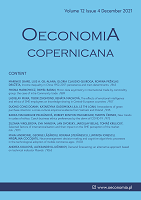Hysteresis and stochastic convergence in Eurozone unemployment rates: evidence from panel unit roots with smooth breaks and asymmetric dynamics
Hysteresis and stochastic convergence in Eurozone unemployment rates: evidence from panel unit roots with smooth breaks and asymmetric dynamics
Author(s): Aysegul Corakci, Tolga Omay, Mubariz HasanovSubject(s): Supranational / Global Economy, Labor relations, Economic policy, EU-Approach / EU-Accession / EU-Development
Published by: Instytut Badań Gospodarczych
Keywords: unemployment hysteresis; stochastic convergence; gradual breaks; asymmetric adjustment; panel unit root;
Summary/Abstract: Research background: Studying the dynamic characteristics of unemployment rate is crucial for both economic theory and macroeconomic policies. Despite numerous research, the empirical evidence about stochastic behaviour of the unemployment rate remains disputable. It has been widely agreed that most economic variables, including unemployment rates, are characterized by both structural breaks and nonlinearities. However, a little work is done to examine both features simultaneously. Purpose of the article: In this paper, we analyse the stationarity properties of unemployment rates of Euro area member countries. Also, we aim to test stochastic convergence of unemployment rates among member countries. Our empirical procedures explicitly allow for simultaneous gradual breaks and nonlinearities in the series. Methods: This paper develops a new unit root test procedure for panel data, allowing for both gradual structural breaks and asymmetric adjustment towards equilibrium. We carry out Monte Carlo simulations to examine small sample performance of the proposed test procedure and compare it to the existing test procedures. We apply the newly proposed test to examine the stochastic properties of the unemployment rates of Euro-member countries as well as relative unemployment rates vis-?-vis the Eurozone unemployment rate. Findings & value added: We find that the newly developed test procedure outperforms existing tests in highly nonlinear settings. Also, these tests reject the null hypothesis of unit root in more cases when compared to the existing tests. We find stationarity in the series only after allowing for structural breaks in the data generating process. Allowing for nonlinear and asymmetric adjustment in addition to gradual breaks provides evidence of stationarity in more cases. Furthermore, our results suggest that relative unemployment rate series are stationary, providing evidence in favour of stochastic convergence in unemployment rates. Overall, our results imply a limited room for coordinated economic policy to fight unemployment in the Eurozone.
Journal: Oeconomia Copernicana
- Issue Year: 13/2022
- Issue No: 1
- Page Range: 11-55
- Page Count: 44
- Language: English

